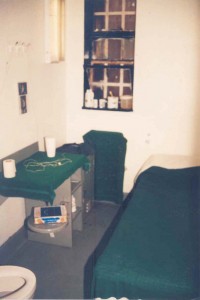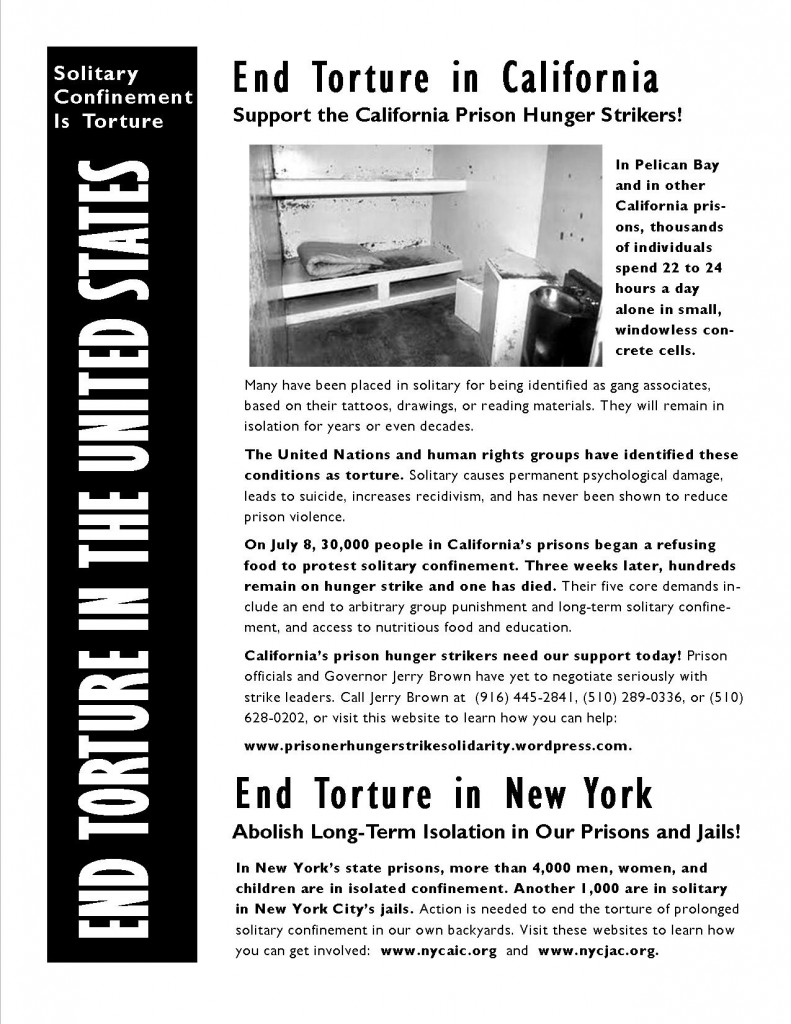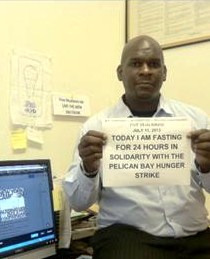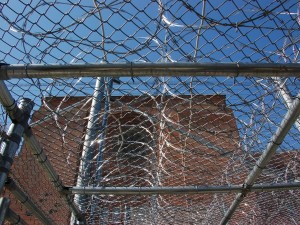By Fran Geteles-Shapiro
November 9, 2013
A new report by the New Mexico Center on Law and Poverty (NMCLP) and the ACLU of New Mexico (ACLU-NM) reports on the systems abuses of solitary confinement, including: overuse; isolation of people suffering from serious mental illness; use of prolonged segregation for the mentally ill; and, the lack of transparency and oversight. Reforms are recommended. http://nmpovertylaw.org/WP-nmclp/wordpress/WP-nmclp/wordpress/wp-content/uploads/2013/10/Solitary_Confinement_Report_FINALsmallpdf.com_.pdf
November 8, 2013
A reporter discusses his visit to the Ad Seg cellblock of a prison in Maine where the typical number of prisoners in isolation has been reduced by more than 50%. He points out that those who remain in solitary are still in grim ugly, super harsh conditions from which there are constant reports of cruelty, inadequate medical care, understaffing, and deliberate mixing of predators and the vulnerable. http://portland.thephoenix.com/news/156318-rare-look-inside-the-maine-state-prisons-‘super/#ixzz2kejcZjsZ
November 6, 2013
A report on Solitary Watch summarizes the findings of the two psychiatrists who were asked by the NYC Board of Corrections to assess whether the city is in compliance with their Mental Health Minimum Standards. Their highly critical report found that the standards are being violated. After the report was published the BOC voted to begin rulemaking to limit the use of solitary confinement in NYC. http://solitarywatch.com/wp-content/uploads/2013/11/Gilligan-Report.-Final.pdf http://solitarywatch.com/2013/11/06/reports-condemn-abuse-solitary-confinement-new-york-citys-jails-officials-weigh-future/
The American Public Health Association (APHA) issued a statement against solitary confinement recommending: people with serious mental illnesses and juveniles be excluded from solitary; people in solitary confinement be closely monitored and removed if their physical or mental health deteriorates or necessary health services cannot be provided; alternative means of discipline should be created; isolation for clinical or therapeutic purposes should be permitted only upon the order of a credentialed health care provider; and, individuals isolated for their personal safety must have access to programs, treatment, education, recreation, visitation, and social interactions comparable to that afforded prisoners in the general population. http://www.apha.org/NR/rdonlyres/AEF53EE6-7E3E-4E87-8731- 4D2C5BB2CF2D/0/C2SolitaryConfinement.pdf
November 3, 2013
A new report from the Taskforce on Preserving Medical Professionalism in National Security Detention Centres says that doctors and psychologists working for the US military violated the ethical codes of their profession under instruction from the defense department and the CIA to become involved in the torture and degrading treatment of suspected terrorists. They were in effect told that their ethical mantra “first, do no harm” did not apply, because they were not treating people who were ill. The taskforce wants rules to ensure doctors and psychiatrists working for the military are prohibited from taking part in interrogation, sharing information from detainees’ medical records with interrogators, or participating in force-feeding, and they should be required to report abuse of detainees. http://www.theguardian.com/world/2013/nov/04/cia-doctors-torture-suspected-terrorists-9-11
November 2, 2013
A summary of quantitative data available about who is held in segregated confinement in our nation’s prisons and jails suggests that in many states the harsh conditions of solitary confinement are probably disproportionately affecting people of color. http://solitarywatch.com/2013/11/02/prison-segregation-racial-disparities/
October 31, 2013
The ACLU of Montana won an agreement regarding access to outdoor exercise for prisoners in a jail. The jail in this case had outdoor recreation for two of its housing units holding adult males, but not for the housing units holding ad seg, female populations and juveniles. The jail has agreed to build recreation areas onto these housing units and provide daily access. http://aclumontana.org/images/stories/documents/litigation/chiefgoesoutsettlement102013.pdf
October 29, 2013
A former prison official and an advocate for the rights of incarcerated people together suggest reforms in the use of solitary confinement in CA and NY: no more applying it to minors or for nonviolent offenses or using it for crowd control; allowing opportunity to read, receive visits, make phone calls, and have other forms of human contact and stimulation; shorter periods of isolation; periodic review; alternative sanctions; and, the use of “conditional discharges” for first-time nonviolent offenders who “clean up their records.” http://www.timesunion.com/opinion/article/Reform-prison-isolation-4933317.php
October 27, 2013
North Carolina Prisoner Legal Services has filed a lawsuit on behalf of a man diagnosed with paranoid schizophrenia who has a history of childhood sexual abuse alleging that he was abused at North Carolina’s Central Prison by guards who repeatedly doused him with excessively high doses of pepper spray, causing him great pain. The suit raises questions about the treatment of individuals in solitary confinement. The plaintiff in the case spent years cycling between cells in the prison mental ward and solitary confinement – often in response to behaviors that are primary symptoms of his illness. http://charlotte.cbslocal.com/2013/10/27/suit-mentally-ill-nc-inmate-often-pepper-sprayed/
October 23, 2013
At the urging of Colorado’s ACLU’s chapter, a senator is sponsoring a bill to find alternatives to the use of so-called administrative segregation for prisoners who have been diagnosed with serious psychological disorders. Citing the recent killing of a state corrections official by a man released directly from solitary confinement, he says, “We are doing the least safe thing.”
http://www.coloradoindependent.com/144572/lawmaker-will-seek-to-abolish-solitary-confinement-for-mentally-ill-prisoners
October 22, 2013
An article for the ACLU discusses the importance of the UN’s efforts to update their Standard Minimum Rules for the Treatment of Prisoners (SMRs) with particular focus on the need for sufficient protections against lengthy solitary confinement. https://www.aclu.org/blog/prisoners-rights/historic-opportunity-advance-international-norms-prisoners-rights
October 19, 2013
Russell Shoatz’s lawyers submitted a communication to Juan E. Mendez, the United Nations’ special rapporteur on torture urging him to inquire into why a “father, grandfather and great grandfather” is being held in extreme isolation despite having a near-perfect disciplinary record for over 20 years. One of the attorneys expressed the hope that an investigation by the office of the special rapporteur will bring an end to indefinite isolation. http://www.ipsnews.net/2013/10/the-u-s-s-64-square-foot-torture-chambers/?utm_content=bufferbdf02&utm_source=buffer&utm_medium=twitter&utm_campaign=Buffer
October 18, 2013
A man in prison in Illinois, who was arrested in the lead up to Occupy Chicago, has been in solitary confinement since July for possessing anarchist literature. He isn’t accused of plotting to harm guards or other incarcerated people, but his political beliefs alone are described as a threat to the safety and security of persons or the facility. http://www.vice.com/read/prisoner-sent-to-solitary-for-copious-amounts-of-anarchist-publications
Juan Méndez, the UN Special Rapporteur on torture, has requested access to California prisons to investigate the use of solitary confinement and ensure that the rights of prisoners’ are being protected. He said he wants access to any part of any prison he chooses and the freedom to speak with any incarcerated individuals of his choosing.” http://www.latimes.com/local/political/la-me-ff-un-torture-investigator-seeks-access-to-california-prisons-20131018,0,15846.story
Amidst growing criticism of its abundant use of solitary confinement, the federal Bureau of Prisons has initiated an audit to review its “restricted housing operations.” But, since the audit has been contracted out to a nonprofit best known as a military think tank and will be conducted largely by former corrections officials, it seems unlikely to bring any dramatic change to the lives of the people held in isolation in the federal prison system. Meanwhile, the federal government has completed purchase of a prison meant to house still more isolation cells. http://solitarywatch.com/2013/10/18/fire-federal-bureau-prisons-audits-use-solitary-confinement-buys-new-supermax-prison/
October 17, 2013
Questions are being raised about whether the extensive use of Secure Housing Units in CA have reduced gang membership or violence in the prisons. Meanwhile prison officials have begun to provide a new “step-down” program which might reintroduce individuals into the general population gradually, over four years. http://kvpr.org/post/do-californias-security-housing-units-reduce-prison-violence
October 16, 2013
Lawyers for individuals who have been condemned to death in CA are asking a U.S. District Judge to require psychiatric hospitalization for the most mentally ill people on death row and to ban the use of pepper spray as a means of controlling them. They showed videos of individuals being drenched with burning pepper spray and dragged from their cells for refusing medication or psychiatric evaluation. Prison officials argue their care is adequate and no one was hurt in the incidents depicted in the videos. http://www.latimes.com/local/political/la-me-ff-prison-lawyers-challenge-care-for-californias-condemned-20131016,0,5753340.story#axzz2iwsid0gN
Anthony Graves, who spent 18 years in prison, 12 of them in solitary confinement on death row in Texas, used funds he received from the state for his wrongful conviction to set up a law school scholarship in the name of Nicole Cásarez, the Houston attorney and journalism professor who fought for eight years to secure his freedom. He also used some of the money to start a foundation to help at-risk children with incarcerated parents. http://www.texasmonthly.com/story/anthony-graves-establishes-scholarship#.Ul7ygaqS5uQ.twitter
October 14, 2013
The US military has announced the end of the six-month mass hunger strike among detainees at Guantánamo Bay, but human rights groups argue that such proclamations are disingenuous as at least 16 inmates are still force-fed daily, and two are in hospital. Also, several of the men and their lawyers have reported that hunger strike participants were coerced into ending their participation in the strike by harsh treatment including isolated confinement, extreme humiliation including forced nudity, temperature manipulation cell searches timed to disrupt their sleep, and denial of their belongings including necessities like eyeglasses. A particular victim of this harsh treatment was Shaker Aamer, though Britain’s Prime Minister is actively trying to have him released and returned to the UK. http://www.theguardian.com/world/2013/oct/12/us-military-stormed-hunger-striker-cell
September 30, 2013
An attorney with the ACLU of VA criticizes recent efforts of the corrections department for failing to include the needs of individuals with serious mental disabilities. She notes the lack of treatment programs. She also discusses the difficulty mentally ill individuals would have adhering to the new step-down program designed to enable people in solitary to earn a return to the general population, pointing out that they are thus likely to remain in solitary indefinitely. http://www.roanoke.com/opinion/commentary/2252289-12/mentally-ill-prisoners-in-solitary-confinement-left-behind.html
September 26, 2013
CCR attorneys for 10 men in solitary confinement at Pelican Bay State Prison in Ashker v. Brown, have asked the courts to make the lawsuit a class-action-suit because hundreds more are suffering in the same appalling conditions and any remedies should apply to everyone affected. The lawsuit alleges that prolonged solitary confinement violates Eighth Amendment prohibitions against cruel and unusual punishment, and that the absence of meaningful review for SHU placement violates the prisoners’ right to due process. http://ccrjustice.org/newsroom/press-releases/hundreds-of-california-prisoners-isolation-should-be-covered-class-action%2C-attorneys-argue-court
Speaking of the recent ending to the hunger strike at Pelican Bay Prison, one of the self described “principal prisoner representatives” said the strike may resume if deemed necessary. One factor in the suspension of the hunger strike was the promise of hearings at the CA state assembly in Sacramento. The representative said he does not share the optimism of outside supporters who hailed a public relations victory when the strike ended, but believes “we have to wait and see what the politicians come up with.” http://www.theguardian.com/world/2013/sep/27/california-prison-hunger-strike-todd-ashker
A strong statement about children in solitary confinement, including the critically relevant issue of children tried as adults. http://www.exposingthetruth.co/children-in-solitary-confinement/?utm_source=feedburner&utm_campaign=Feed:+ExposingTheTruthco+%28Exposing+The+Truth.co%29&utm_content=bufferefd8b&utm_medium=twitter#axzz2gCliceb0
As part of a federal class-action lawsuit brought last year by the ACLU of Illinois, three court-appointed experts found that Illinois’ youth prison system is violating the constitutional rights of young people in their custody by failing to provide adequate mental health care and education and by unnecessarily keeping youths in solitary confinement of “harsh and of substandard quality.” They pointed out the inadequate staffing, including the fact that there is not a single psychiatrist specializing in children and adolescents. Negotiations to fix the problems are currently in progress. http://www.chicagotribune.com/news/local/ct-met-illinois-youth-prison-20130926,0,4795774.story
September 23, 2013
A 61-year-old man with a history of violence and murder which occurred many years ago while he was in prison, who has since been in solitary confinement for 30 years under a “no human contact” order, has challenged this “cruel and unusual treatment.” Although mental health experts have diagnosed severe emotional and cognitive effects, a U.S. District Court supported the Bureau of Prison’s assertions that he has been unharmed by this extreme isolation because it has not deprived him of life’s basic necessities. The case is now before the U.S. Tenth Circuit Court of Appeals. http://www.coloradoindependent.com/144083/denver-judge-to-weigh-how-much-is-too-much-solitary-confinement
September 21, 2013
The Texas Tribune analyzed data from violent-incident reports from 99 state prisons filed from 2006 to 2012, and found: far more reports of violence at facilities housing high numbers of mentally ill and violent incarcerated people than at other prisons; reports of violent episodes are more prevalent at smaller institutions that house only psychiatric patients; and, there are more incidents of officers using force at these facilities. Advocates the numbers show that the state’s approach to incarcerating the mentally ill is not working, but criminal justice department officials argue that the state facilities are safe, and programs aimed at helping mentally ill individuals are working. http://www.nytimes.com/2013/09/22/health/a-tie-to-mental-illness-in-the-violence-behind-bars.html?utm_content=buffer92df3&utm_source=buffer&utm_medium=twitter&utm_campaign=Buffer&_r=0
September 16, 2013
Albert Woodfox of the Angola 3, who has been in solitary confinement for over 40 years, has gone to court requesting a restraining order against the state of LA to stop strip and cavity searches, which he says occur whenever he leaves his cell – i.e. “as often as six times a day.” After the Angola 3 sued against such searches in the late 70s, a consent decree was agreed to by the parties which held that they violated the rights of these men and must be curtailed or ceased. However, when the judge responsible for the decree died recently, the searches were re-instated, thus requiring the return to court. http://www.theatlantic.com/national/archive/2013/09/a-handwritten-letter-the-prison-system-doesnt-want-you-to-see/279751/






Follow the #HALTsolitary Campaign